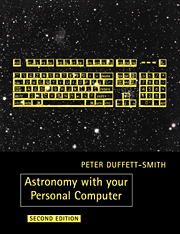Book contents
- Frontmatter
- Contents
- Preface
- Using your personal computer for astronomy
- DEFAULT: default value input routnine & YESNO: ‘Y’ or ‘N’ input routine
- MINSEC: converts between decimal hours/degrees and minutes/seconds form
- JULDAY: calendar date to Julian day number since 1900 January 0.5
- CALDAY: Julian day number since 1900 January 0.5 to calendar date
- TIME: converts between local civil and sidereal times
- EQHOR: converts between equatorial and horizon coordinates
- HRANG: converts between right ascension and hour angle
- OBLIQ: calculates the value of the obliquity of the ecliptic
- NUTAT: finds corrections for nutation in longitude and obliquity
- EQECL: converts between equatorial and ecliptic coordinates
- EQGAL: converts between equatorial and galactic coordinates
- GENCON: converts between any of the coordinate systems
- PRCESS1: approximate precession of equatorial coordinates & PRCESS2: rigorous precession of equatorial coordinates
- PARALLX: converts between geocentric and apparent position
- REFRACT: calculates the effect of atmospheric refraction
- RISET: finds the circumstances of rising and setting
- ANOMALY: solves Kepler's equation for elliptical motion
- SUN: finds the ecliptic coordinates of the Sun
- SUNRS: finds the circumstances of sunrise and sunset
- PELMENT: returns the orbital elements of the major planets
- PLANS: finds the position of a planet
- MOON: finds the position and parallax of the Moon
- MOONRS: finds the circumstances of moonrise and moonset
- MOONNF: finds the times of new and full moon
- ECLIPSE: finds the circumstances of lunar and solar eclipses
- DISPLAY: displays an eclipse in graphical form
- ELOSC: finds positions from osculating elliptical elements
- RELEM: converts elliptic orbital elements from one epoch to another
- PCOMET: finds the position of a comet from parabolic elements
- PFIT: finds parabolic elements from observations & EFIT: finds elliptical elements from observations
- List of variables
- Bibliography
- Index
- PROGRAMS AVAILABLE ON DISK
TIME: converts between local civil and sidereal times
Published online by Cambridge University Press: 17 February 2010
- Frontmatter
- Contents
- Preface
- Using your personal computer for astronomy
- DEFAULT: default value input routnine & YESNO: ‘Y’ or ‘N’ input routine
- MINSEC: converts between decimal hours/degrees and minutes/seconds form
- JULDAY: calendar date to Julian day number since 1900 January 0.5
- CALDAY: Julian day number since 1900 January 0.5 to calendar date
- TIME: converts between local civil and sidereal times
- EQHOR: converts between equatorial and horizon coordinates
- HRANG: converts between right ascension and hour angle
- OBLIQ: calculates the value of the obliquity of the ecliptic
- NUTAT: finds corrections for nutation in longitude and obliquity
- EQECL: converts between equatorial and ecliptic coordinates
- EQGAL: converts between equatorial and galactic coordinates
- GENCON: converts between any of the coordinate systems
- PRCESS1: approximate precession of equatorial coordinates & PRCESS2: rigorous precession of equatorial coordinates
- PARALLX: converts between geocentric and apparent position
- REFRACT: calculates the effect of atmospheric refraction
- RISET: finds the circumstances of rising and setting
- ANOMALY: solves Kepler's equation for elliptical motion
- SUN: finds the ecliptic coordinates of the Sun
- SUNRS: finds the circumstances of sunrise and sunset
- PELMENT: returns the orbital elements of the major planets
- PLANS: finds the position of a planet
- MOON: finds the position and parallax of the Moon
- MOONRS: finds the circumstances of moonrise and moonset
- MOONNF: finds the times of new and full moon
- ECLIPSE: finds the circumstances of lunar and solar eclipses
- DISPLAY: displays an eclipse in graphical form
- ELOSC: finds positions from osculating elliptical elements
- RELEM: converts elliptic orbital elements from one epoch to another
- PCOMET: finds the position of a comet from parabolic elements
- PFIT: finds parabolic elements from observations & EFIT: finds elliptical elements from observations
- List of variables
- Bibliography
- Index
- PROGRAMS AVAILABLE ON DISK
Summary
The basis of all civil timekeeping on the Earth is Universal time, UT. It is a measure of time which conforms, within a close approximation, to the mean daily motion of the Sun. Roughly speaking, the time is 12 : 00 noon UT when the Sun crosses the meridian at Greenwich, and 24 hours of UT is the time between two successive passages of the Sun across that meridian. However, the Sun is not really a very good timekeeper. Although the Earth spins about its polar axis at a nearly-constant rate (there are small irregular perturbations), the position of the Sun in the sky changes daily due to the orbit of the Earth about the Sun. If that orbit were perfectly circular, and if the Earth's axis were exactly perpendicular to the plane of the orbit (the ecliptic), then the daily passage of the Sun would be regular throughout the year. In reality, the Earth's orbit is slightly elliptical so that the speed of the Earth varies throughout the year, and the Earth's axis is tilted by about 23.5 degrees from the perpendicular to the plane of the ecliptic. Both these effects cause the time measured by a sundial, true solar time, to run fast during some parts of the year and slow during others by up to 16 minutes with respect to a uniform clock. The difference between the solar time and the uniform clock is called the ‘equation of time’, and you would need to know its value if you wished to tell the time accurately from a sundial.
- Type
- Chapter
- Information
- Astronomy with your Personal Computer , pp. 29 - 36Publisher: Cambridge University PressPrint publication year: 1990



